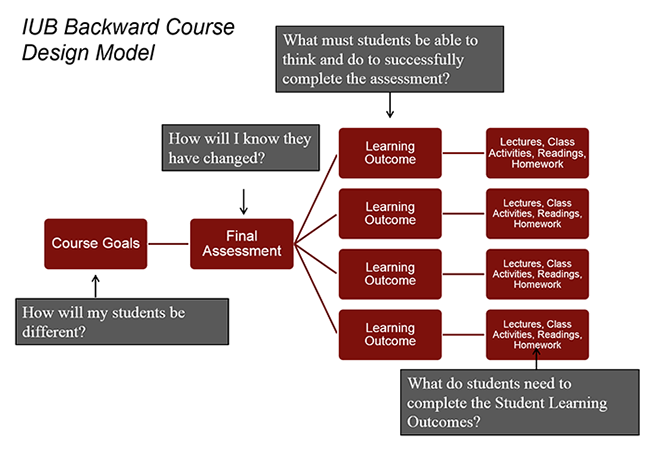Effective course design relies on close alignment of learning outcomes, assessments of student learning, and learning activities and teaching strategies. To meet these goals, we suggest that you use the backward design model (Wiggins and McTighe, 2005) when designing or redesigning your course, whether that course is a lecture, discussion or lab. In the backward design process you structure student learning based upon assessments that are intentionally designed to provide evidence that students have achieved the course goals.
The first step in backward course design is to clearly articulate the final results of the course. Begin by asking yourself:
- What do I want my students to be able to think and do by the end of this course?
- How will my students be different by the end of the course?
The answers to these questions are the course goal(s).
Many teachers refer to A Taxonomy For Learning, Teaching and Assessing (Anderson, Krathwohl 2001) as a guide for writing course goals in specific and measurable language. The taxonomy is based upon cognitive learning processes that move from lesser to greater levels of abstraction and complexity. Goals can be organized around one or more of these:
- Remember – retrieve knowledge from long-term memory
- Understand – construct meaning by interpreting, classifying, summarizing, inferring and comparing knowledge
- Apply – perform a familiar or unfamiliar task using knowledge
- Analyze – differentiate, organize and attribute knowledge
- Evaluate – judge and critique knowledge
- Create – generate and produce new knowledge
After creating your course goals the next step is to determine how you know that students have changed. What evidence will students provide to you demonstrating that they have achieved the course goals? The answer to this question is often your final assignment or assessment for the course.
Once you have decided upon the final assessment it is now time to identify the things students will need to “think and do” in order to successfully complete it. These are the learning outcomes for the course.
Finally, you are ready to structure the course content, student activities, homework and lectures, all of which are based upon the learning outcomes.

This diagram licensed under CC BY-SA 4.0 by the Indiana University Course Development Institute (Kurz, L., Metzler, E., & Rehrey, G.)
Keep in mind that lectures facilitate learning at the lower end of the taxonomy, while discussions, problem-solving, writing, and other more interactive teaching strategies tend to facilitate higher-order learning processes, such as analysis and evaluation. Your choice of teaching strategies should reflect the levels of thinking and learning in which you want students to be engaged.
Implementation
The CITL's Course Development Institute (CDI) provides a structure for building a course from learning outcomes up, following the backwards design model. This is an excellent opportunity for IUB instructors to (re)design a course using the backward design model. CDI is offered each spring, immediately following the completion of the spring semester.
Instructors examining backward course design might also investigate the asynchronous modules in the Teaching for Student Success (TSS) course designed by IU's Faculty Academy for Excellence in Teaching (FACET). This course focuses on backward design and alignment of outcomes, assessments, and learning activities.
References
The backward course design process used by instructors at IUB has been modified and adapted from Wiggins, G., & McTighe, J. (2005). Understanding by Design. Alexandria: Association for Supervision and Curriculum Development.
For more about writing goals, assignments and learning outcomes in measurable language that is based upon cognitive learning processes, see Anderson, L. W., Krathwohl, D. R., Airasian, P. W., Mayer, R. W., Pintrich, P. R., Raths, J., & Wittrock, M. C. (2001). A taxonomy for learning teaching and assessing.(Complete ed.). New York: Longman.
For More Help or Information
Contact CITL to meet with a consultant.

